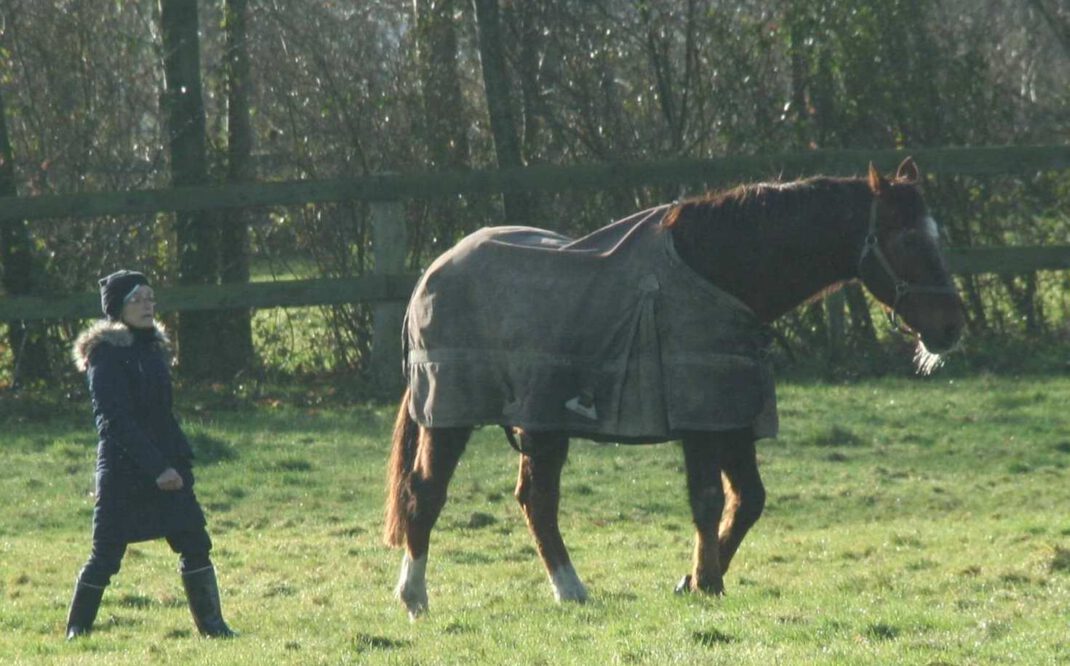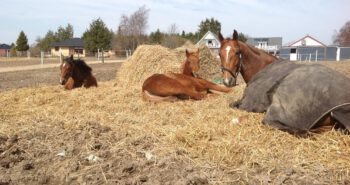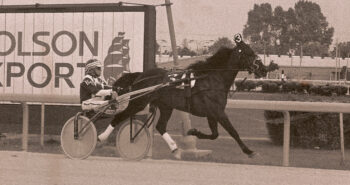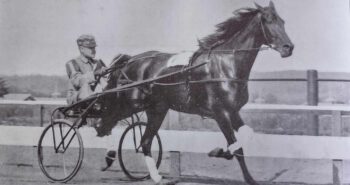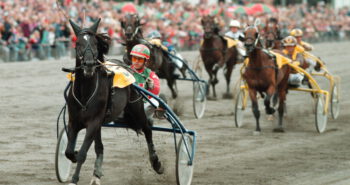He was the undisputed French emperor for several years, and only illness prevented him from winning an unprecedented five Prix d’Amerique-wins in a row. As tough off as on the track, Ourasi was a handful for those around him. He was actually more than a handful for his competitors, who simply couldn’t resist the complete package of strength, speed and an insane will to win. In one race the other competitors even colluded to prevent the chestnut superstar from winning, but Ourasi won anyway.
The big, burly colt born 1980 was first trained and driven by one of his owners, the nearly deaf Raoul Ostheimer, at 2, and was 0-1-1 in 4 starts. After three starts, Ostheimer felt justified in his lack of belief in the massively built chestnut who he believed as both too lazy and too heavy. Rachel Tessier, Ostheimer’s ex-wife who still lived with the trainer, had formed a special bond with Ourasi, however, as saw something special in the colt. Soon the French trotting public would see it, too. On Dec 8, 1982, Ourasi made his first start at Vincennes in the Prix des Acacias. Despite a poor start, Ourasi goes around his competitors one by one. He doesn’t manage to catch up to the winning Ovenutar, but his second place finish make numerous horsemen take notice.
Going back to Vincennes, Ourasi was again a very impressive second, this time to Ocarino d’Anjou, in the Prix de Maray-le-Monial on Jan 6, 1983. Now several people are ready to make offers. According to Jose Coves’ ten-page article story on Ourasi on Equidia, Ali Hawas and Pierre-Desire Allaire offer Ostheimer a lot of money for the three-year-old, but he decides to keep the horse. Tessier instead convinces him to entrust the horse to legendary trainer Jean-René Gougeon, nicknamed the Pope of Vincennes. The move paid off as Gougeon and Ourasi immedately won their first race together, a smaller race for three-year-olds in January 83. The following month the duo surprisingly won one of the biggest races for 3-year-olds in France, the Criterium des Jeunes. Already one of the best in his crop, Ourasi grew into a totally dominant trotter over the next two seasons. He was 4-5-0 in 9 starts at 3. He had some consistency issues at 4, but from then on started to dominate like few others had done before him. At 3, Orco got the better of Ourasi on several occasions, winning both the Criterium des 3 ans and Prix Abel Bassigny head of the chestnut trotter.
The horse was already the strongest, but as a youngster he still lacked speed. In the Prix de Selection at 4, two year older Mon Tourbillon easily won despite a 25 meter handicap. Minou du Donjon and Monquier took the two next spots, while Ourasi finished fourth. With time, Ourasi became the complete package. He was 9-2-1 in 13 starts at 5 and a perfect 14 for 14 at 6.
Overcoming collusion
At 5, his win in the Prix Rene Balliere that season is one of the most legendary in history. That one driver attempts to control the favorite by keeping him or her boxed in is, in itself, nothing new. But it is impossible for one driver to control everything – sometimes the biggest opponents find an opening anyway. However, what if all drivers work together against the one big favorite? Though it may seem bizarre, that was exactly what happened in the 1986 Prix Rene Balliere. Ourasi and Jean Rene Gougeon came into the race with seven consecutive wins, including five group 1-wins and was as close as unbeatable as one can get. Ourasi had post 1 and since he never left quickly this gave the other horses an opportunity. The French monster stayed boxed into most of the race. However, half-way down the final stretch the tiniest of openings presented itself and Ourasi showed and unbelieveable speed and acceleration to win the race.
In 1986 Ourasi also won his first Prix d’Amerique. The following year saw the chestnut tank put in a performance truly worthy of a champion when he won the big race after staying three- and even four-wide until the last turn, just leaving the field in the dust down the final stretch at Vincennes. In 1988 it was more or less the same although the second-finisher, Permissionnaire, was closer to him. However, the win itself was never in danger. Ourasi had an extreme will to win. If he appeared beaten, the summoned more energy, stretched his neck and gave it his all.
A supreme will to win
A prime example of this is the Åby Stora Pris in 1988. A flying Sugarcane Hanover passed Ourasi as the field were turning for home, but the French emperor just refused to lose. In the end Sugarcane Hanover, suffering from sore hooves, broke stride while Ourasi came back to win.
This fighting spirit was also on display in the March of Dimes at Garden State Park in 1988 where Ourasi wore down Mack Lobell despite being parked outside most of the race. Ourasi didn’t get the better of Mack Lobell because he was faster, he got the better of him because he wanted to. Mack could outsprint Ourasi over a quarter any day of the week, but no speed in the world could save him when Ourasi went to work on his competitor over a longer distance. As they turned for home something always seemed to click in Ourasi’s head. Tom Sells and Go Get Lost had three lengths on Ourasi on top of the stretch in the 1989 Oslo Grand Prix but when Ourasi, parked outside, started moving Go Get Lost stood no chance. Being parked outside was Ourasi’s home, his office, really. They didn’t want him in the lead because he could get lazy or his mind wander and Jean-Rene wanted him parked outside to keep him sharp in the race.
As they turned for home in the March of Dimes the commentator appropriately stated that “they are at war.” Whoever Ourasi was at war with, he came out on top. Had the March of Dimes been a 1/16th longer he probably would have countered Sugarcane’s winning surge – just as he did at Åby. Despite losing the big race to Sugarcane Hanover, the Ourasi clan was happy with the race. Their horse had beaten Mack Lobell, supposedly the world’s best horse, on his home turf. The owners of Mack Lobell had supposedly demanded that if they were to race Ourasi it would have to be in the US, thinking this would give them an advantage. If they wanted an advantage they should have exploited Ourasi’s only weakness and picked a half-mile track: Ourasi was a horse for the big tracks with nice, gentle turns. At a half-mile track Mack Lobell, with his perfect gait, would probably gain 3-4 lengths on every turn.
“I didn’t drive him, rather he drove me”
For Ourasi’s never-say-die attitude in the final stretch, he often appeared lazy and disinterested midway through the race. This attitude contributed to the legend of Ourasi, and earned him his French nickname, “Le Roi Fainéant”, the lazy king. Abroad he was, however, due to his dominance, usually refered to as “the Emperor” or “the French emperor.”
While the horse was legendary, so was his trainer. Jean-René Gougeon has trained stars like Roquepine, Une de Mai and Bellino II. To him, however, Ourasi stood out above the rest: “He had everything, he is the horse that I have admired the most, in his way of doing things, in his behavior, in the training and in the race, but he was also a dull knife, who never gave the it his all. He was a bit headstrong, especially in his paddock, and he did not pay attention. He was not really annoying, but he only worked when he felt like it – if he had been forced to do so, he could have got it wrong. He did it differently every time, but always impressively. I once drove to the front early and then he just stopped, I did not know what was happening to me, but in the last turn with Ourasi we did not have anything anymore… I didn’t drive him, rather he drove me. He was the champion of the explosion, his most beautiful victory was his second Prix d’Amérique, He had everything left in the last turn, while the others were already struggling to keep up, I hesitated to let Ourasi go, I didn’t want to humiliate the others too much. But I did not think too long, knowing that he liked it and the audience would go crazy. I let go out of the final turn. He put his ears back and went off enthusiastically under the cheers of the audience to win with more than 20 lengths. I had a great experience with him, the audience, his owner and myself. It was fantastic. The feeling you then have is formidable. You feel in the seventh heaven. I wish all my colleagues to experience that feeling once in their careers.”
The shock loss
Two months after the March of Dimes, Ourasi was back at the Vincennes for his fourth Prix d’Amerique. However, the horse had been sick prior to the race. He horse finished third, but was not his usual self The French president Francois Mitterand had even shown up for the occasion to hand out the trophy, and the shock was great when Queila Gede won. Ourasi had again had a tough trip, but whereas he’d usually break his competition down the final stretch, this time he simply couldn’t find the energy for a decisive knock-out.
A few days later, Jean-Rene Gougeon suffered a heart attack. He continued to trained the lazy king, but his brother Michel-Marcel Gougeon drove the horse in the remaining races in his career. One month later he was back to his old self, winning the Prix de Paris despite a very game Reve d’Udon giving it his all to win. Ourasi wore down the three-years younger challenger as they were nearing the finish line, in the end winning by half-a-length.
Reve d’Udon would get his revenge in that year’s Prix Rene Balliere, winning ahead of Napoletano and Quilon. Ourasi would then get a six-months break, returning for the Prix du Bourbonnais in December. A second-place in that race was followed with poor performance in the Prix de Belgique. This concerned nervousness ahead of the 1990 Prix d’Amerique. The hope was that Ourasi would win and become historic as the first trotter to win the prestigious race a record four times. In the end there was nothing to worry about as the king was again dominant. Trotting outside the leading Pussy Cat, Ourasi heaped on the pressure through the last turn. Turning for home, Ourasi stormed away to another impressive victory.
The 10 year court battle
However, in the last few seconds something happened that would cause a long court battle. As can be seen on the video, Minou Gougeon raised his right hand in celebration, then dropped it and his whip to the ground just before the finishing line. This caused Potin d’Amour to go offstride and the latter’s owner sued the owner and driver of Ourasi. After all the second place finish was worth 114,337 euros. The case was first ruled in the favour of Ourasi’s owners and driver, Minou Gougeon, in Rouen on Oct 28, but Marquise De Moratalla, owner of Potin d’Amour had the ruling quashed on appeal on Mar 19, 1997. A year later, on Jun 18, 1998, a court in Caen found in the Marquise’s favour. Again the decision was appealed, but on Oct 26, 2000 the appeal was rejected, thus settling a 10-year battle.
Ourasi finished his career 58-14-4 in 86 starts. His personal best was 1.11,5 (1:55), from the March of Dimes, and career earnings of 21,782,895 francs, 3,320,781 euros. Ourasi won a total of 24 group 1-races in his career. Looking back at his career in 2004, Jean-Rene Gougeon revealed a major regret. “It is a pity that he was beaten by Queila Gede as a 9-year-old, as he was much better than the rest in those days, but he had a problem with his kidneys at the time. Two weeks before he won the Prix de Belgique easily despite a 25 meter handicap, I also regret that we did not start the Prix d’Amérique at the age of 5. At that point he was already the best in Europe.”
Infertility
He was syndicated for a huge amount and there were massive expectations but he proved nearly sterile, a syndication which followed after a court-battle between Ostheimer and Tessier where the latter was ousted from her role as part-owner. Ourasi covered a full book of 100 mares in 1991 but only had 14 foals to show for it the following year. In total he sired a total of 41 foals in 5 years at stud and and had only 1 foal in each of the last two years. Ourasi was retired from stud and lived out the rest of his life as a king at Haras de Grouchy in Normandie, not too far from Omaha Beach. The lazy king was not an easy horse there either, but mellowed considerably as he aged. In retirement he formed a special bond with Annie Jumel, who would stop by every day with apples and carrots and take care of the big colt.
Ourasi was put down on Jan 12, 2013, after a brief spell of sickness, which had prevented him from eating for several days. The following year, on Jun 22, 2014, a statue of the legendary horse, made by Arnaud Kasper, was unveiled at Vincennes.
Ourasi
Chestnut colt born in Saint-Étienne-l’Allier, France on Apr 7, 1980. Died in Mosles, France on Jan 12, 2013.
Greyhound – Fleurasie (Remember)
86 starts: 58-14-4 – Fastest win: 1.12,7 (1:57s) – Fastest time: 1.11,5 (1:55) – € 3,320,781
Breeder: Raoul Ostheimer
Owners: Raoul Ostheimer and Rachel Tessier – Raoul Ostheimer – Ourasi syndicate
Trainers: Raoul Ostheimer and Jean-Rene Gougeon
Drivers: Raoul Ostheimer, Jean-Rene Gougeon, Richard W Denechere and Michel-Marcel Gougeon
Grooms: Rachel Tessier and Philippe Renouf

